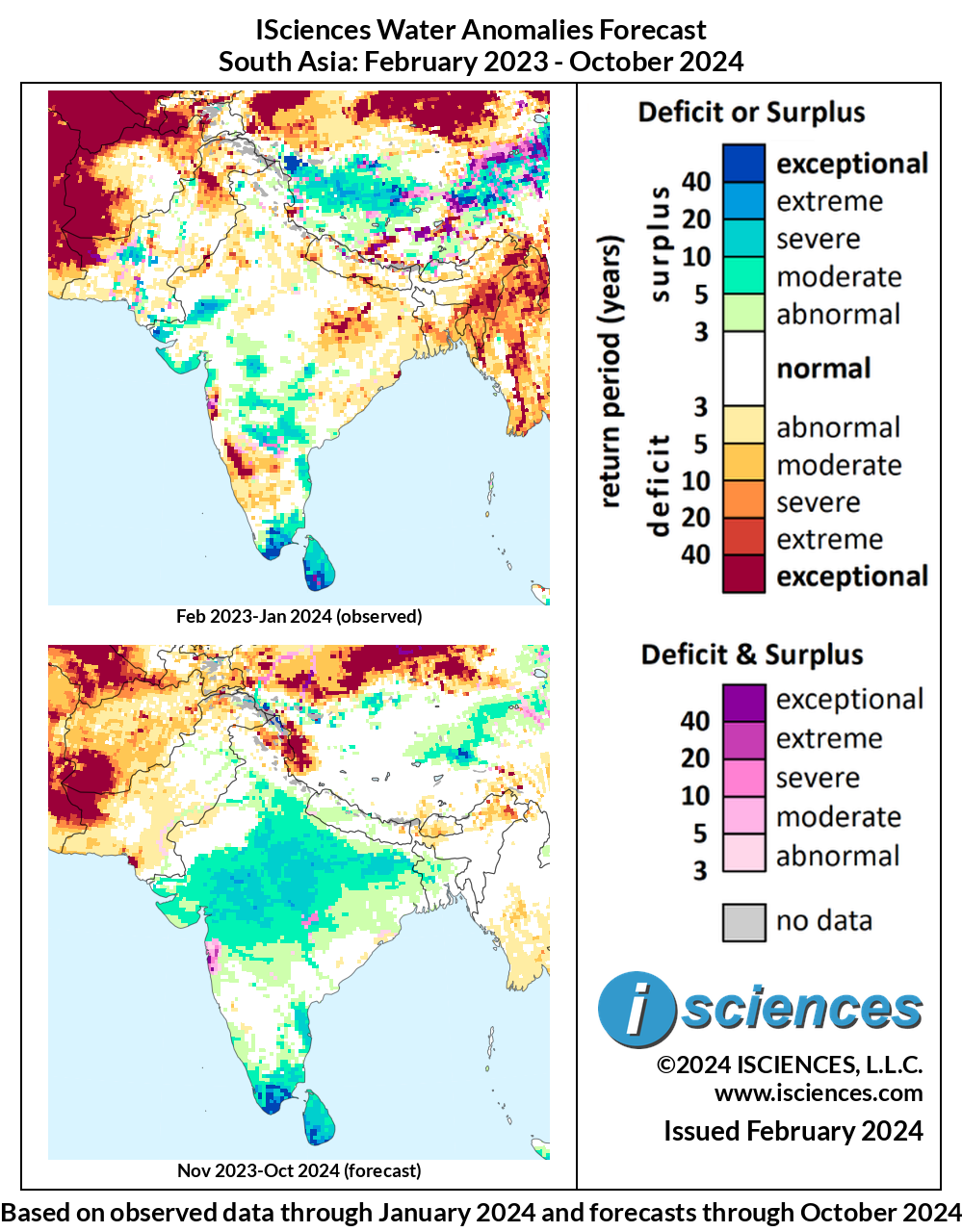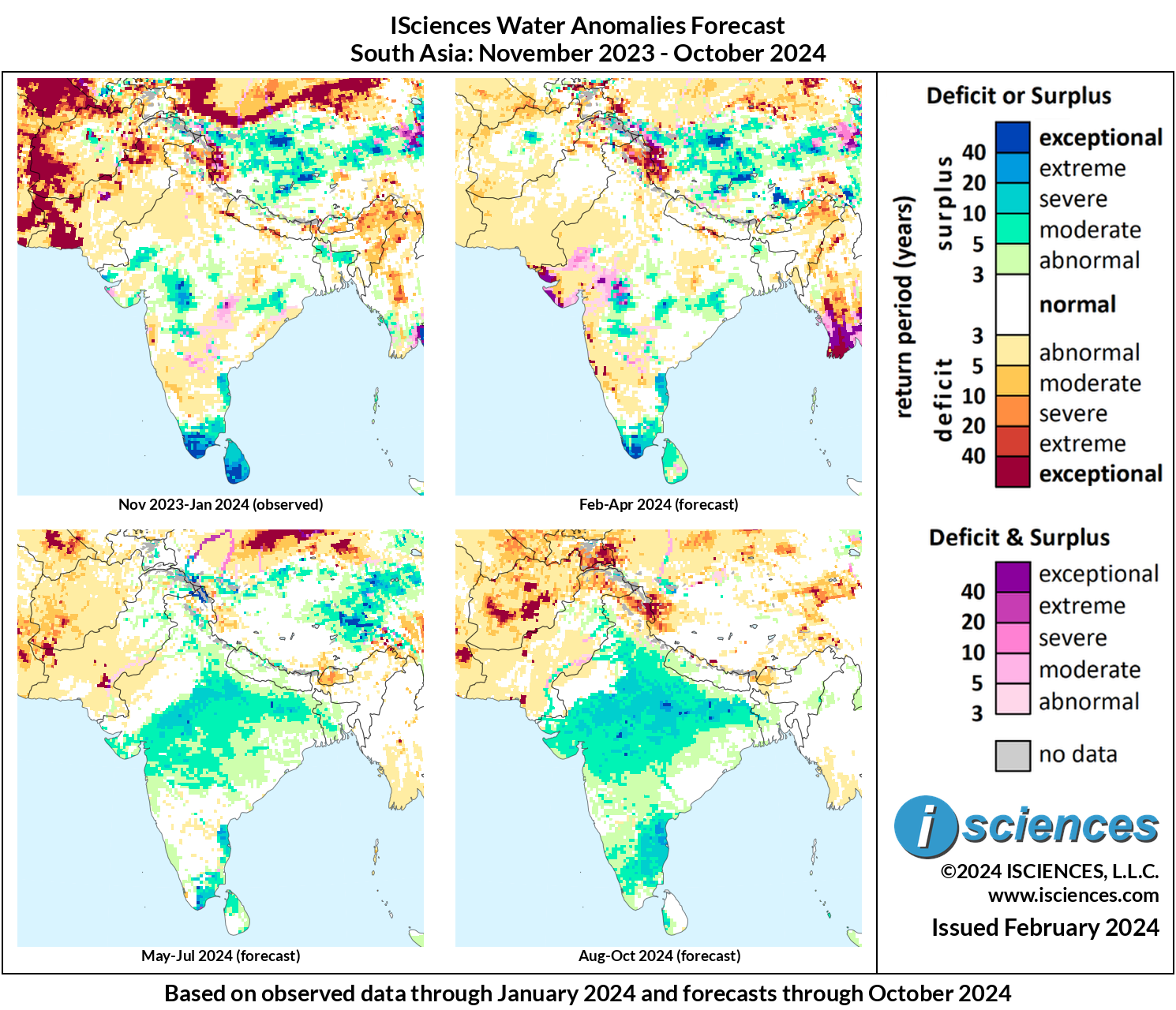South Asia: Surplus expands throughout India
24 February 2024
THE BIG PICTURE
The 12-month forecast ending in October 2024 anticipates moderate to severe surplus to spread significantly throughout India. Extreme to exceptional deficits are expected to resolve in Bangladesh, but continue in Afghanistan and Pakistan.
Severe to exceptional surpluses are expected in the following regions:
Central India, widespread throughout the states of Madhya Pradesh, eastern Rajasthan, southern Uttar Pradesh, and Bihar.
Southern India, with the most intense surpluses appearing in southern coastal regions of the Kanyakumari District.
Sri Lanka, with the highest concentrations appearing in southwestern coastal regions of the country.
Extreme to exceptional deficits are expected in the following areas:
Southern Pakistan, throughout the Nimruz Province.
Western Afghanistan, throughout the Balochistan Province.
Northern India, in the easternmost regions of Ladakh.
The 3-month maps (below) show the evolving conditions in more detail.
FORECAST BREAKDOWN
The forecast through April 2024 anticipates that pockets of intense surplus will linger in central India in Madhya Pradesh, as well as in eastern coastal regions of Andhra Pradesh, and southern regions of the Kanyakumari District. Isolated, intense deficits are expected to appear in western coastal regions of Gujarat, as well as some emergence of transition conditions in the same areas. Northern regions of Bangladesh can expect severe to extreme deficits, as well as northern regions of India and Afghanistan. Sri Lanka can expect moderate to severe surplus to continue in its northern areas.
From May through July 2024, moderate to severe surplus is expected to expand throughout most central regions of India, as well as further east into Bihar, and west into coastal regions of Gujarat. Surpluses in southern regions of India are expected to persist, as well as in northern regions of Sri Lanka. Small regions of eastern and western Pakistan are expected to observe exceptional deficits, as well as southern portions of Afghanistan. Much of the rest of the region can expect near-normal to abnormal conditions.
The forecast for the final months – August 2024 through October 2024 – anticipates surplus to expand further throughout central and southern India. In central Afghanistan, pockets of exceptional deficits are expected to emerge, as well as further east, in eastern Ladakh.
Please note that WSIM forecast skill declines with longer lead times.
IMPACTS
The National Institute for Health and Care Research recently initiated a £3 million project to support patients at high health risk during India floods. India has the world’s second highest rates of heart disease and diabetes, and during periods of flooding, reports of patients not able to receive medical care were documented, causing their conditions to worsen. A team of researchers led by the University of Birmingham are developing a system to ensure operations and increase accessibility to patients during floods. Project lead Semira Manaseki-Holland, from the University of Birmingham, stated that “floods in India have become more frequent, unpredictable, and severe but current warning systems are inadequate to prepare either population or health services. We aim to improve the preparedness and resilience of patients and health systems during flood-emergencies in managing long-term conditions such as diabetes, heart disease, and lung diseases.”
Reports of increases in domestic violence during periods of drought were reported in Sri Lanka. As families fall into poverty due to crop deaths and loss of income, researchers and affected women say men can sometimes take frustrations out on family members, particularly women. Sri Lanka is among the countries most affected by extreme weather events, and though attempts have been made to increase resilience, the country is still grappling with the aftermath of its worst financial crisis in decades, which took place in 2022. It is estimated that almost 19 million Sri Lankans live in places that could become hot spots for moderate to severe flooding or drought by 2050.
The government of Karnataka has announced plans to restrict agricultural water usage due to intense drought brought on by monsoon failure. Of the 236 taluks in the state, 216 have been affected by drought. The last quota of water for agricultural purposes is 2.75 TMC, which will be released to farmers in Upper Krishna. Government officials have also advised on which crops get the rationed water, said Deputy Chief Minister and Water Resources Minister D K Shivakumar. “Some farmers have planted chilies instead of paddy. If this crop is destroyed, the estimated loss will be around Rs 2,000 crore,” he added.
NOTE ON ADMINISTRATIVE BOUNDARIES
There are numerous regions around the world where country borders are contested. ISciences depicts country boundaries on these maps solely to provide some geographic context. The boundaries are nominal, not legal, descriptions of each entity. The use of these boundaries does not imply any judgement on the legal status of any territory, or any endorsement or acceptance of disputed boundaries on the part of ISciences or our data providers.
Subscribe to our monthly Water Watch List
Search blog categories
- *Precip/Temp Outlooks 101
- *Press Releases 1
- *Special Topics 16
- *Water Watch Lists 107
- Africa 117
- Australia & New Zealand 102
- Canada 103
- Central Asia & Russia 101
- East Asia 101
- Europe 108
- Mexico & C. Amer. & Carib 106
- Middle East 110
- South America 115
- South Asia 106
- Southeast Asia & Pacific 110
- United States 107
Search blog tags



